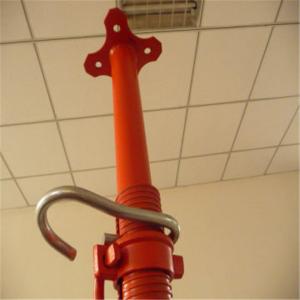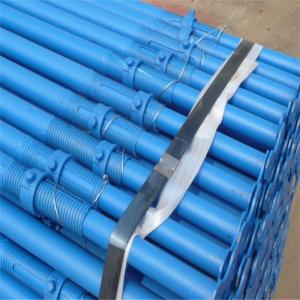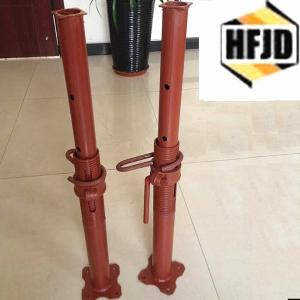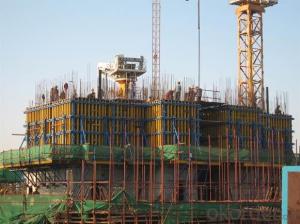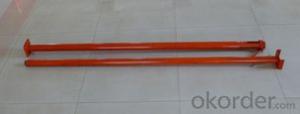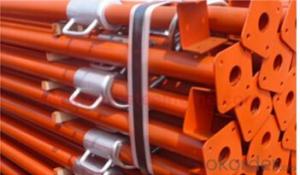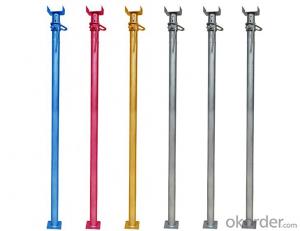steel props
- Loading Port:
- China Main Port
- Payment Terms:
- TT OR LC
- Min Order Qty:
- -
- Supply Capability:
- -
OKorder Service Pledge
OKorder Financial Service
You Might Also Like
Detailed Product Description
suspended slab formwork
slab form work
concrete slab formwork
150 Aluminum Frame Early Dismantling Slab Formwork With Adjustable Prop
Description:
1. Brief introduction
Especially for projects with a large number of similar applications and open facades, Alu-slab system is the right solution. The panel is end product, no assembling on site and it is easily to build, ease of application, more important thing is, the panel is light weight, a dead lift is achieved, save time and effort.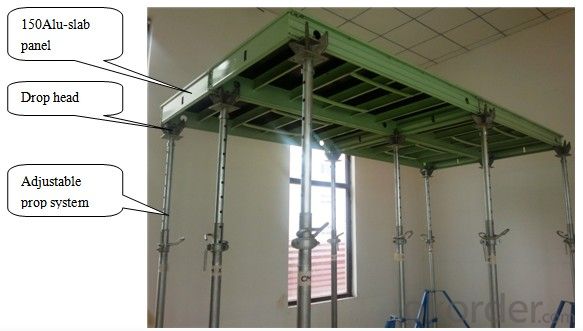
2. Competitive advantage
① Light weight but high load bearing capacity
The panels could be transported by manual work so that it greatly reduces the aggregate cost, accelerates the erection speed, and all in all increases the aggregate benefit.
②Quickly turnover of slab panels
The early dismantling prop system speed up the turnover of the panels, minimize the investment, lower the cost, improve the working efficiency, and shorten the project period under the precondition of keeping the concrete structure and safety uninfluenced, in line with the erection requirement and ensuring the project quality.
③Cost effective with early dismantling prop system.
This early dismantling system is simple, safe and fast, saving at least 50% percent of your construction time.
3. Applications
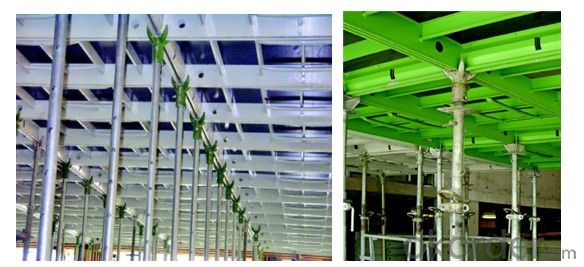
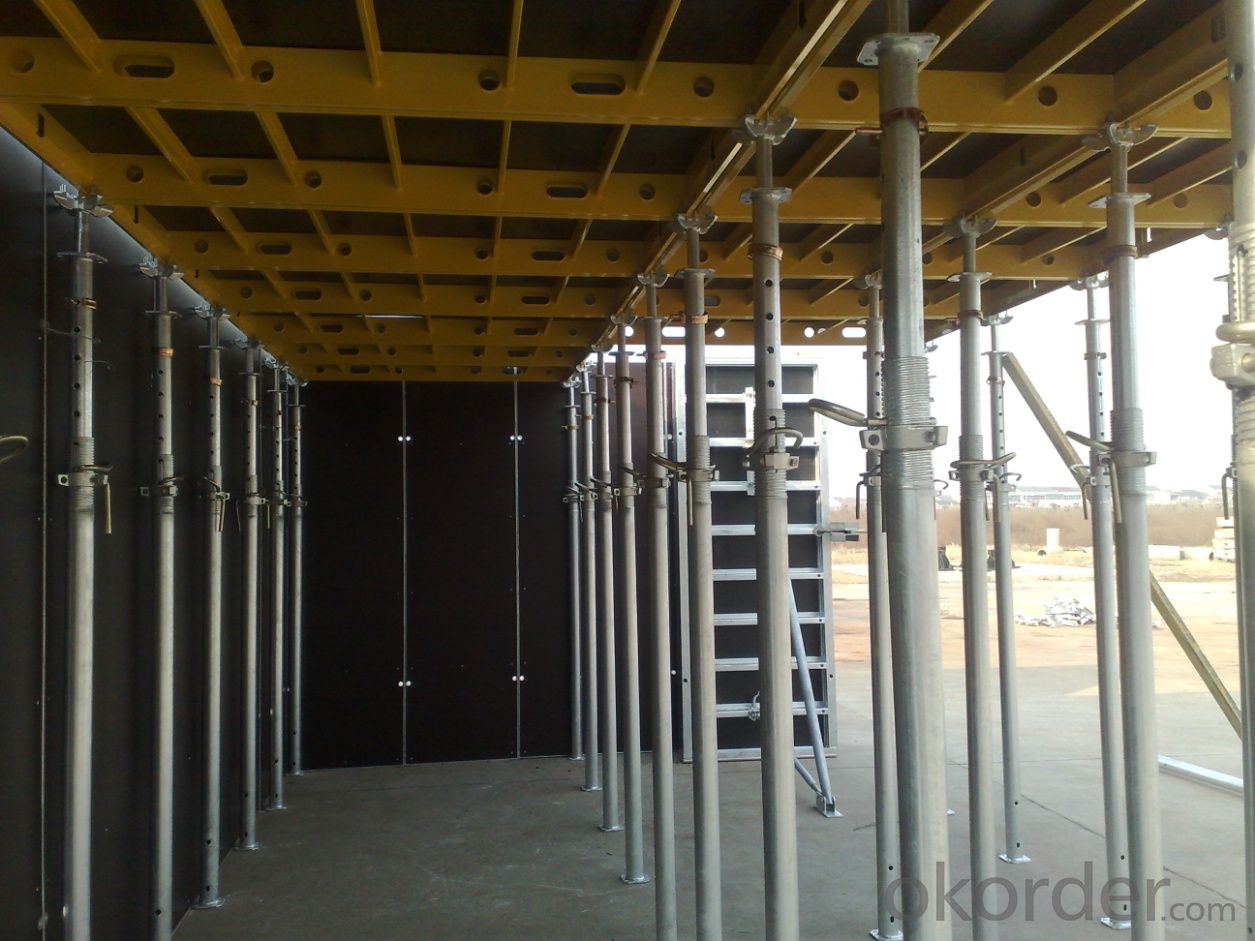
- Q:Can steel props be used in the construction of manufacturing facilities?
- The utilization of steel props in the construction of manufacturing facilities is possible. Referred to as steel shores or acrow props, steel props are adjustable supports that are commonly employed in construction to offer temporary support throughout the building process. They are built from steel and possess a telescopic design, enabling them to be adjusted to the required height. Within the realm of constructing manufacturing facilities, steel props have diverse applications. A primary use involves providing support to formwork or scaffolding systems. Formwork is employed to establish molds or frames for pouring concrete, while scaffolding is utilized to create a secure working platform for laborers. Steel props serve to supplement the support of these structures, guaranteeing stability and safety throughout the construction phase. Additionally, steel props can be employed for facilitating the installation of heavy loads or equipment. Manufacturing facilities often necessitate the installation of heavy machinery, equipment, or production lines. By utilizing steel props, temporary support is provided during these installations, ensuring proper load distribution and averting potential accidents or damages. Moreover, steel props can be utilized to bolster temporary structures like mezzanines, walkways, or platforms. These structures are commonly employed in manufacturing facilities to optimize space utilization and create supplementary work areas. Steel props furnish the necessary support to ensure the stability and safety of these temporary structures. In summary, steel props are versatile and dependable temporary support systems, which find application in the construction of manufacturing facilities. They play an indispensable role in ensuring the stability, safety, and efficiency of the construction process, making them an indispensable component in the successful completion of manufacturing facility projects.
- Q:Can steel props be used in supporting temporary formwork systems?
- Certainly! Temporary formwork systems can be supported by steel props. Construction projects often rely on steel props to provide stability to temporary structures like formwork systems. These props are known for their strength and durability, enabling them to withstand heavy loads. Moreover, they can be adjusted in height, offering flexibility for various formwork heights and configurations. Not only are steel props easy to install and dismantle, but they can also be reused, making them a cost-effective choice for supporting temporary formwork.
- Q:Can steel props be used for temporary support in dam construction?
- Yes, steel props can be used for temporary support in dam construction. Steel props are commonly used in construction projects to provide temporary support to structures during construction or repair work. They are strong, durable, and can be easily adjusted to different heights and angles, making them suitable for various construction applications, including dams. In dam construction, steel props can be used to provide support and stability to concrete formwork, scaffolding, and other temporary structures. They can help distribute the weight of the construction materials and equipment evenly, preventing any structural failures or collapses during the construction process. Furthermore, steel props offer the advantage of being reusable, which can be cost-effective in long-term construction projects. They can be easily dismantled and reassembled at different locations within the dam construction site, allowing for flexibility and adaptability as the project progresses. However, it is important to note that the design and specification of steel props for dam construction should comply with relevant engineering standards and regulations to ensure the safety and stability of the temporary structures. Proper planning, supervision, and maintenance are also essential to minimize any potential risks or hazards associated with the use of steel props in dam construction.
- Q:What are the standard weight and dimensions of steel props?
- Steel props can have varying weight and dimensions depending on the type and manufacturer. Typically, they come in different sizes and weight capacities to meet various construction needs. To measure the dimensions of steel props, their length, diameter, and thickness are commonly considered. The length can range from approximately 1.8 meters (6 feet) to 5 meters (16.4 feet) or more, depending on the specific application. The diameter can vary from around 40 millimeters (1.6 inches) to 75 millimeters (3 inches) or more. The thickness of the steel tubes used in props can range from about 2 millimeters (0.08 inches) to 5 millimeters (0.2 inches) or more. In terms of weight, steel props are designed to support different load capacities. The weight of a steel prop can differ based on the length, thickness of the tube, and the load it is intended to bear. Generally, steel props can weigh between 10 kilograms (22 pounds) to 30 kilograms (66 pounds) or more. It is important to note that these dimensions and weights are general guidelines and can vary depending on the specific manufacturer and intended use of the steel props. To obtain accurate and reliable information about the weight and dimensions of steel props, it is recommended to consult the manufacturer's specifications or guidelines.
- Q:Are steel props more expensive than other support systems?
- Steel props can be more expensive compared to other support systems, depending on various factors. Steel props are typically made from high-quality steel, which makes them durable and able to bear heavy loads. This quality comes at a cost, as the manufacturing and materials used in steel props tend to be more expensive than other support systems made from different materials, such as wood or aluminum. Furthermore, steel props often require a higher level of engineering and expertise in their installation and maintenance. This can add to the overall cost, as specialized labor and equipment may be necessary for their proper use. Additionally, steel props may have a longer lifespan compared to other support systems, which can be a factor in their higher initial cost. However, it is important to note that the cost of support systems can vary depending on the specific requirements of a project. In some cases, other support systems may be more expensive due to unique circumstances or specific needs. Therefore, it is crucial to consider the specific requirements, load capacities, and longevity needed for a project before determining if steel props are more expensive than other support systems.
- Q:How do you ensure proper leveling of steel props?
- To ensure proper leveling of steel props, there are a few key steps that need to be followed. Firstly, it is important to check the ground conditions where the props will be placed. The ground should be firm and even, without any loose soil or debris. If necessary, the ground can be compacted or leveled using a compactor or a levelling tool. Next, the steel props themselves should be inspected for any damage or defects. It is crucial to use props that are in good condition and suitable for the intended load. The props should also be of the correct height for the specific application. When placing the props, it is essential to use a spirit level to ensure they are perfectly vertical. This can be done by adjusting the height of the prop using the prop adjustment mechanism. The spirit level should be placed on top of the prop and checked from all sides to ensure accuracy. Additionally, it is recommended to use a prop plate or a solid base under the prop to distribute the load evenly and prevent any sinking or tilting. The prop plate should be placed on a stable surface, such as a concrete slab or a steel plate. Once the props are in place, they should be periodically checked and adjusted if necessary. This is particularly important if there are any changes in load or ground conditions that could affect the leveling of the props. In summary, ensuring proper leveling of steel props involves checking the ground conditions, inspecting the props, using a spirit level for vertical alignment, using a prop plate for stability, and regularly monitoring and adjusting the props as needed. By following these steps, a safe and stable support system can be established.
- Q:Can steel props be used for supporting heavy machinery?
- Yes, steel props can be used for supporting heavy machinery. Steel props are strong, durable, and capable of withstanding heavy loads, making them suitable for supporting heavy machinery in various industrial applications.
- Q:What are the different types of steel prop couplers available?
- There are several different types of steel prop couplers available for various construction applications. Here are some of the commonly used types: 1. Sleeve Couplers: These are the most basic type of prop couplers and are typically used to join two props together. They consist of a cylindrical sleeve that fits over the end of two props and is secured with bolts or pins. 2. Swivel Couplers: Swivel couplers are designed to allow props to be connected at different angles or to join props with different diameters. They have a swiveling mechanism that allows for flexibility in positioning. 3. Internal Couplers: Internal couplers are used to connect two props from the inside. They are inserted into the hollow end of the props and secured in place with bolts or pins. 4. External Couplers: External couplers, as the name suggests, are used to join two props from the outside. They are placed over the external surface of the props and fastened with bolts or pins. 5. Gravity Lock Couplers: Gravity lock couplers are designed to provide a secure connection between two props without the need for additional fasteners. They rely on gravity and friction to hold the props in place. 6. Quick Release Couplers: Quick release couplers allow for easy and rapid assembly and disassembly of props. They typically have a spring-loaded mechanism that allows for quick adjustment or removal of props. 7. Adjustable Couplers: Adjustable couplers are used to connect props of different lengths or to provide height adjustment. They have a threaded mechanism that allows for easy adjustment of prop length. 8. Wedge Couplers: Wedge couplers are used to provide a strong and rigid connection between two props. They have a wedge-shaped design that locks the props together when inserted. These are just a few examples of the different types of steel prop couplers available. The choice of coupler will depend on the specific requirements of the construction project, such as the type of props being used, the load capacity needed, and the desired level of adjustability or flexibility.
- Q:Can steel props be used in construction of retaining walls?
- Yes, steel props can be used in the construction of retaining walls. Steel props, also known as steel shores or steel acrows, are commonly used in construction to provide temporary support during various stages of the building process. When constructing a retaining wall, steel props can be used to support the wall structure while it is being built, ensuring stability and preventing collapse. The steel props are adjustable, allowing them to be set at the desired height and angle to provide adequate support. Additionally, steel props are durable and can withstand heavy loads, which makes them suitable for supporting the weight of retaining walls. However, it is important to design and engineer the retaining wall and the use of steel props according to the specific requirements and conditions of the project, as different retaining wall designs may require different support systems.
- Q:How do you ensure proper stability when using steel props on soft soil?
- To ensure the stability of steel props on soft soil, there are several steps that can be taken: 1. Conduct a thorough soil investigation to understand the properties and characteristics of the soft soil. This will help determine the appropriate design and dimension of the steel props, taking into account the specific soil conditions. 2. Calculate the load that will be placed on the steel props, considering the weight of the structure, additional loads, and the factor of safety. This will ensure that the steel props can bear the required load without causing instability. 3. Place the steel props in the correct locations, considering the layout and load distribution of the structure. This will help evenly distribute the load and minimize pressure on the soft soil. 4. Ensure proper spacing between the steel props to prevent excessive load concentration on any particular area of the soft soil, reducing the risk of instability. 5. If necessary, reinforce the soft soil using techniques like soil stabilization or ground improvement methods. This can involve adding materials such as compacted soil, stone columns, or geosynthetics to improve the soil's strength and stability. Additionally, securely anchor the steel props to prevent lateral movement or tilting. 6. Regularly monitor the performance of the steel props and the stability of the soft soil through visual inspections, measurements, and periodic assessments. This will help identify any signs of instability or potential issues, allowing for prompt action to maintain stability. By implementing these measures, one can ensure that steel props are appropriately designed, positioned, and supported to provide stability when working on soft soil conditions.
1. Manufacturer Overview |
|
|---|---|
| Location | |
| Year Established | |
| Annual Output Value | |
| Main Markets | |
| Company Certifications | |
2. Manufacturer Certificates |
|
|---|---|
| a) Certification Name | |
| Range | |
| Reference | |
| Validity Period | |
3. Manufacturer Capability |
|
|---|---|
| a)Trade Capacity | |
| Nearest Port | |
| Export Percentage | |
| No.of Employees in Trade Department | |
| Language Spoken: | |
| b)Factory Information | |
| Factory Size: | |
| No. of Production Lines | |
| Contract Manufacturing | |
| Product Price Range | |
Send your message to us
steel props
- Loading Port:
- China Main Port
- Payment Terms:
- TT OR LC
- Min Order Qty:
- -
- Supply Capability:
- -
OKorder Service Pledge
OKorder Financial Service
Similar products
New products
Hot products
Hot Searches
Related keywords







